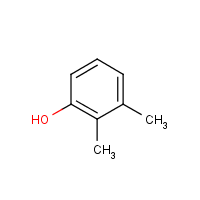2,3-Dimethylphenol
Agent Name
2,3-Dimethylphenol
CAS Number
526-75-0
Formula
C8-H10-O
Major Category
Other Classes

Synonyms
1-Hydroxy-2,3-dimethylbenzene; 2,3-Xylenol; Benzene, 1,2-dimethyl-3-hydroxy-; Phenol, 2,3-dimethyl-; Vic-o-Xylenol; Xyellenol 100; o-3-Xylenol; o-Xylenol; [ChemIDplus] UN2261
Category
Phenols
Description
Colorless or brown solid; [CAMEO] Crystalline solid; [MSDSonline]
Sources/Uses
Used as a solvent, antioxidant (gasoline, lubricating oil, and elastomers), and to make coal tar disinfectants and synthetic resins; [HSDB]
Comments
Commercial mixtures are toxic by ingestion and skin absorption; [HSDB] Corrosive to tissues; Inhalation may cause laryngeal spasm, edema of the bronchi, and chemical pneumonitis; May cause injury to liver and kidneys; [CAMEO] May cause burns; [eChemPortal: ESIS] A corrosive substance that can cause injury to the skin, eyes, and respiratory tract; Inhalation may cause chemical pneumonitis; May be absorbed through skin; [MSDSonline] "As the six dimethylphenol isomers and the mixed isomer substance are generally similar in toxicity, a common TLV for these substances is appropriate. . . . In mice, oral exposure to 250 mg/kg/day produced changes in blood parameters including statistically significant decreases in mean corpuscular volume and mean corpuscular hemoglobin concentration (4 and 3% reduction in mean values, respectively. . . . Available data on skin sensitization from exposure to dimethylphenol are mixed but warrant the addition of a DSEN notation. . . . All six dimethylphenol isomers were tested in a mouse local lymph node assay and the results found 2.4, 2,5, and 3,4-dimethylphenol to be positive for skin sensitization." There are no epidemiology studies. In a case report, ingestion of about 250 ml of a mixture of dimethylphenol isomers resulted in CNS depression, hypotension, and death. [ACGIH] See "Phenol."
Biomedical References
Exposure Assessment
TLV (ACGIH)
1 ppm, inhalable fraction and vapor
Vapor Pressure
0.089 mm Hg
Lethal Concentration
LC (rat) > 85.5 mg/m3/4h
Explanatory Notes
The Guide in the Emergency Response Guidebook is for "Xylenols, solid."
Adverse Effects
Toxic Pneumonitis
Yes
Neurotoxin
Other CNS neurotoxin
Hepatotoxin
Hepatoxic (a) from occupational exposure (secondary effect) or (b) in animal studies or in humans after ingestion
Dermatotoxin
Skin burns
ACGIH Carcinogen
Confirmed Animal
Diseases, Processes, and Activities Linked to This Agent
Processes
Industrial Processes with risk of exposure: